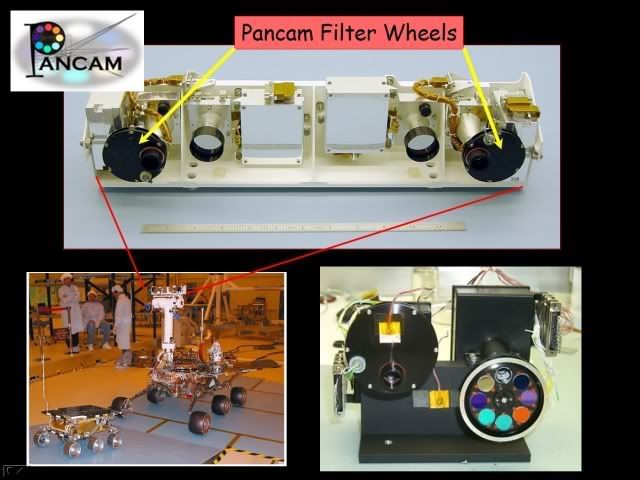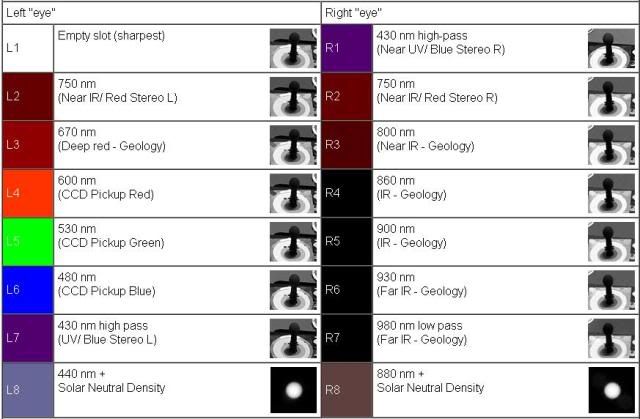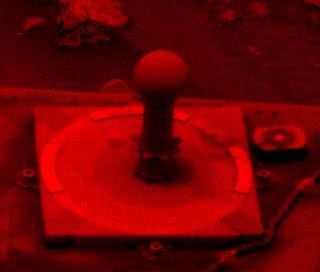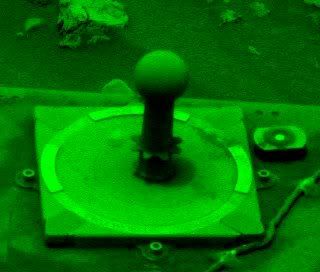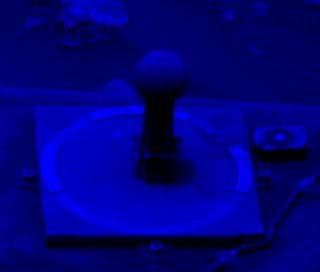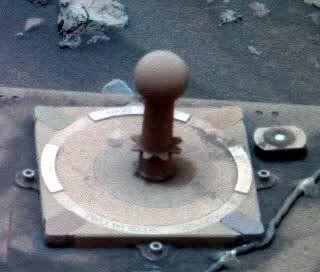It looks like you're using an Ad Blocker.
Please white-list or disable AboveTopSecret.com in your ad-blocking tool.
Thank you.
Some features of ATS will be disabled while you continue to use an ad-blocker.
share:
I am studying on how to colorize Mars photos. I want to try my hand on it
I am studying this right now.
marswatch.astro.cornell.edu...
I am studying this right now.
marswatch.astro.cornell.edu...
The thing about these pictures is: if you apply the same true-color filter to a reddish image on earth, you get the same result: A bluish-white sky
and a more neutral ground. That doesn't debunk the occasional red sky or red environment here on earth. The reason that the sky is so brownish on
Mars is because so much of it is dusty. That plays a huge role in what the rover sees. Also, the wind storms there are quite frequent, more frequent
than tornadic events in a given area on earth. That is why dust is such a problem with the rover and not as much of a problem with solar panels on
earth. The dust has a ton of copper oxide particles in it and so many images are red. If the dust is down, the sky is more gray-bluish. These ideas
that because a filter makes the planet look habitable and thus there is a cover up don't hold up. Sounds like the speculation that the moon had a
ancient civilization living on it from the late 1800s.
Originally posted by newagent89
The thing about these pictures is: if you apply the same true-color filter to a reddish image on earth, you get the same result: A bluish-white sky and a more neutral ground. That doesn't debunk the occasional red sky or red environment here on earth. The reason that the sky is so brownish on Mars is because so much of it is dusty. That plays a huge role in what the rover sees. Also, the wind storms there are quite frequent, more frequent than tornadic events in a given area on earth. That is why dust is such a problem with the rover and not as much of a problem with solar panels on earth. The dust has a ton of copper oxide particles in it and so many images are red. If the dust is down, the sky is more gray-bluish. These ideas that because a filter makes the planet look habitable and thus there is a cover up don't hold up. Sounds like the speculation that the moon had a ancient civilization living on it from the late 1800s.
But the wind isnt always kicking up the dust, if it was then the rovers would never get any sunlight onto their solar pannels becasue they would always be covered with this dust. Even in some of the black and white images from these rovers you can see there is no dust blowing around. And in some of the red saturated images, those also show no dust being blown around.
For example my first image I posted that is leaning to the left, which btw that is how NASA published it. Do you see any dust flying around in there?
I sure dont. And if there was, those rocks and tracks in the photo would not look so clear, they would be obscured by the blowing dust.
So in some of the images, not all of them, but some of them your not going to have red oxidized dust flying around. It is these images that we are examining here. And just becasue it is only a handfull of images, that does not discredit the result from them just becasue on the rest, the wind is blowing red dust everywhere and causes images to look red.
If you take one of those red images with dust blowing everywhere, and try a white balance on something white on the rover, the result would be is that you would still see the red dust in the air in the image. Your next point of reference at that point would be to check the color chart tabs on the sundials if it is in the image. If those still look red, green and blue after your white balance, then your close enough for a compensated image to account for all that red dust.
Again not all of the images are filled with flying dust. And even NASA has stated that there are calm days on Mars.
Color correcting an image doesnt mean the planet is habitable. It is merely a thought, a question. And without questions, there can be no answers. And if we dont question the answers, there can be no truth.
We are also not trying to redefine scientific analysis. This is merely experimentation, exploration and discovery. And if I wanted to take this hobby out to the 11th million decimal point, then I wouldnt be spending my time in here at ATS, I would be hanging out at a university somewhere bugging the hell out of some planitary geologist. The goal here isnt to overrun or outdo the tiny accepted realm of meanstream science, it is to explore on our own and if it is close, perhaps it is good enough to intriqe some people to perhaps take another look, or even spark an interest in what NASA is doing and maybe, just maybe that might help revivie the drive that NASA and the public needs to get the space program going again, and it also serves as a good alternative to all this doom and gloom stuff going around. A healthy diversion never hurts anyone.
Cheers!!!!
[edit on 11-12-2008 by RFBurns]
Originally posted by Deaf Alien
I am studying on how to colorize Mars photos. I want to try my hand on it
I am studying this right now.
marswatch.astro.cornell.edu...
Cool deal DA! Keep us updated on your progress! I too am looking over the other thread links posted earlier. Lots to discover!!
Cheers!!!!
All of this about the air being breathable and the 'blue' sky producing rain is mere speculation (Though there is snow!). I've already said that
this true color thing can apply to red environments here on earth, but is that red just pretend red? Because when you apply a filter it looks like it
could also be a picture taken here on earth? Does that mean that red skies are a conspiracy to make the earth look uninhabitable? The moon looked
desolate when we sent probes, but, just like Mars, we wanted to go there. NASA is not trying to make it look uninhabitable. In the long range, they
want to send people there. In the longer range: a lot of people. That is the long range point of NASA: to pave the way for mankind to spread out
through and better understand the cosmos. Not to scare us into staying here on earth, that would deny the spirit and the romantic danger of
exploration. Basing mistrust of NASA on a phenomena in coloring that could "debunk" sunsets here on earth is preposterous. To believe that sort of
stuff requires one to change their viewpoints on many things, often from a speculative point of view. Then they get wrapped up in a belief in a huge
NWO conspiracy belief which inhibits their usefulness the real world and stops progress and rational thought.
Originally posted by newagent89
All of this about the air being breathable and the 'blue' sky producing rain is mere speculation (Though there is snow!). I've already said that this true color thing can apply to red environments here on earth, but is that red just pretend red? Because when you apply a filter it looks like it could also be a picture taken here on earth? Does that mean that red skies are a conspiracy to make the earth look uninhabitable? The moon looked desolate when we sent probes, but, just like Mars, we wanted to go there. NASA is not trying to make it look uninhabitable. In the long range, they want to send people there. In the longer range: a lot of people. That is the long range point of NASA: to pave the way for mankind to spread out through and better understand the cosmos. Not to scare us into staying here on earth, that would deny the spirit and the romantic danger of exploration. Basing mistrust of NASA on a phenomena in coloring that could "debunk" sunsets here on earth is preposterous. To believe that sort of stuff requires one to change their viewpoints on many things, often from a speculative point of view. Then they get wrapped up in a belief in a huge NWO conspiracy belief which inhibits their usefulness the real world and stops progress and rational thought.
The only person I see so far saying its all a conspiracy is you and that other skeptical poster who plastered the thread with 5+ repetitive posts, tho I am sure that was some glitch or something and not purposely done.
No one is trying to change viewpoints here. Do I have a gun to anyone's head saying "believe me or else"? Have I stated anywhere in this entire thread that my own personal opinion is the absolute and ye shall not believe in any other belief? NO I dont think I have, nor has the OP of this thread, nor has anyone else.
Again its all pure speculation and experimentation with a few photos. Were not trying to change the world, but you know what, if it does intrique a few members into looking into any of it further, and even intriques memebers to ask what if...well where is the harm in that eh?
The only people that have griped are you and that other poster. Im sure the flood will show up soon enough, but really, if you all think its that much nonsense, then please we dont need your input, we already know the script of the skeptic.
I would be glad to have you and any other skeptic participate, but I dont make that call, I dont own this forum and I am not the one who started this thread. I am simply adding my 2 cents. And I dont have a problem with a contribution from the skeptic side. So I wont stand in your way..just make sure you dont stand in mine ok? Fair enough? Cool.
Cheers!!!!
[edit on 11-12-2008 by RFBurns]
BTW, have you taken a look at that sunset image link I posted on page 1?
That is another direct published NASA photo. I see blue in that there sunset, it looks to me like a typical western desert sunset. In fact I think I even made that comment too.
Cheers!!!!
That is another direct published NASA photo. I see blue in that there sunset, it looks to me like a typical western desert sunset. In fact I think I even made that comment too.
Cheers!!!!
(my two paragraph, semi-angry, typical ATS poster response):
When I mentioned conspiracy, I was not talking about that poster that talked and then multi posted. I was concerned about what fatality and deaf alien said a few pages back (I know that this was said mainly in jest and had really no bearing on the personal opinions of the posters). One wondered if the air was breathable based on the true color evidence. The second said that those sorts of questions make NASA sweat. Someone else thought there might be rain. Seemed like foreshadowing of a down-the-road thread derailment. I worried about where this thread would go: would it degenerate once the OP and follow up posters left it? I hate it when these sorts of pages turn into conspiracy pages. I may disagree with your point but I do value this page's right to address a topic.
If you think that I am the one starting to make this page degenerate, that is certainly not true (you never said this but in case you feel like it). Luckily, no one but you seemed to care what I said regarding conspiracies. I did not anticipate my post to go far, and I was not targeting anyone specifically. It's just the case that way too many of these pages are allowed to become fights about the government's intentions and absurd things. Lastly, you know not to swear on these forums. That's what really degenerates the integrity of a page. But really, check out this page that was mentioned a page or two ago. It is a great explanation on the mars sundial topic:
www.abovetopsecret.com...
[edit on 11-12-2008 by newagent89]
When I mentioned conspiracy, I was not talking about that poster that talked and then multi posted. I was concerned about what fatality and deaf alien said a few pages back (I know that this was said mainly in jest and had really no bearing on the personal opinions of the posters). One wondered if the air was breathable based on the true color evidence. The second said that those sorts of questions make NASA sweat. Someone else thought there might be rain. Seemed like foreshadowing of a down-the-road thread derailment. I worried about where this thread would go: would it degenerate once the OP and follow up posters left it? I hate it when these sorts of pages turn into conspiracy pages. I may disagree with your point but I do value this page's right to address a topic.
If you think that I am the one starting to make this page degenerate, that is certainly not true (you never said this but in case you feel like it). Luckily, no one but you seemed to care what I said regarding conspiracies. I did not anticipate my post to go far, and I was not targeting anyone specifically. It's just the case that way too many of these pages are allowed to become fights about the government's intentions and absurd things. Lastly, you know not to swear on these forums. That's what really degenerates the integrity of a page. But really, check out this page that was mentioned a page or two ago. It is a great explanation on the mars sundial topic:
www.abovetopsecret.com...
[edit on 11-12-2008 by newagent89]
reply to post by newagent89
Thanks for the link. I have read it and find it valuable and valid. The part I dont fully agree with in Krono's conclusions is the part about NASA giving us the full story in regards to the images and a few other things that he is not discussing in that analysis. And I dont think, or imply that your trying to derail the thread or discussion at all, I did say tho that I would enjoy other points of view and participation by those who do have more input to contribute. I enjoy those kinds of discussions.
You know what is so interesting about all this color of Mars issue. It is the by far the most controversial issue I think out of all the rest. Even more so than the face or cities under poof dirt.
I fully agree with you about how things would appear in the images when the blowing red dust is flying all over the place. That would certianly cause much of the red in the pictures. But that would also cause obstruction. Just like how blowing dust here on Earth makes everything look blocked out or hazed out, that same effect would be true on Mars as well. There are alot of the images that do not show obstruction by blowing red dust. These are good candidate images for trying to obtain a white balance on white objects, then checking the adjustment to the color calibration tabs on the sundial.
Granted these adjustments are not going to be science level precision, but were not shooting for that. Even in the mainstream scientific community, there is such as thing as tolorance, a plus or minus factor. Nothing is absolute or perfect. And I nor anyone else in this discussion is trying to achieve precision. Just a close approximation to see what it may look like.
I was working with another image from the Viking probe some years ago and noticed how odd it was that the blue on the flag and the blue on the color chart were more of a purple color than blue. The green appeard to be more of a darker shaded green and the red, well the red was red.
After applying a white balance on the white parts of the Viking probe, that blue in the flag and the blue on the color chart became blue, and the green was more enhanced, and the red stayed its normal red. And after making sure the color chart was showing a red, green and blue squares, the sky also turned blue, and the ground had a more brownish red color than just red. Even the dust on the probe looked more brownish.
I dont know what time of day on Mars that picture was taken, but based on the shadow of the antenna mast, it looked like it could have been late morning or or early afternoon Mars time. That told me that the sunlight was almost directly on top of the probe, giving me a somewhat even spread of light on the white parts to make the white balance adjustment, and veifying the white with the color chart squares, which also contained a white square.
It seems that the color of Mars on a clear day is not so red afterall, at least that is what the image is telling me.
Cheers!!!!
Thanks for the link. I have read it and find it valuable and valid. The part I dont fully agree with in Krono's conclusions is the part about NASA giving us the full story in regards to the images and a few other things that he is not discussing in that analysis. And I dont think, or imply that your trying to derail the thread or discussion at all, I did say tho that I would enjoy other points of view and participation by those who do have more input to contribute. I enjoy those kinds of discussions.
You know what is so interesting about all this color of Mars issue. It is the by far the most controversial issue I think out of all the rest. Even more so than the face or cities under poof dirt.
I fully agree with you about how things would appear in the images when the blowing red dust is flying all over the place. That would certianly cause much of the red in the pictures. But that would also cause obstruction. Just like how blowing dust here on Earth makes everything look blocked out or hazed out, that same effect would be true on Mars as well. There are alot of the images that do not show obstruction by blowing red dust. These are good candidate images for trying to obtain a white balance on white objects, then checking the adjustment to the color calibration tabs on the sundial.
Granted these adjustments are not going to be science level precision, but were not shooting for that. Even in the mainstream scientific community, there is such as thing as tolorance, a plus or minus factor. Nothing is absolute or perfect. And I nor anyone else in this discussion is trying to achieve precision. Just a close approximation to see what it may look like.
I was working with another image from the Viking probe some years ago and noticed how odd it was that the blue on the flag and the blue on the color chart were more of a purple color than blue. The green appeard to be more of a darker shaded green and the red, well the red was red.
After applying a white balance on the white parts of the Viking probe, that blue in the flag and the blue on the color chart became blue, and the green was more enhanced, and the red stayed its normal red. And after making sure the color chart was showing a red, green and blue squares, the sky also turned blue, and the ground had a more brownish red color than just red. Even the dust on the probe looked more brownish.
I dont know what time of day on Mars that picture was taken, but based on the shadow of the antenna mast, it looked like it could have been late morning or or early afternoon Mars time. That told me that the sunlight was almost directly on top of the probe, giving me a somewhat even spread of light on the white parts to make the white balance adjustment, and veifying the white with the color chart squares, which also contained a white square.
It seems that the color of Mars on a clear day is not so red afterall, at least that is what the image is telling me.
Cheers!!!!
reply to post by spitefulgod
well, what if we see mars as the red planet from millions of miles away, but in reality, the earths atmosphere and humidity tampers with the true colors of mars. maybe the same way the moon is sometimes orange or red, because of the humidity. but the only difference is that the moon is a hell of a lot closer than mars, thus making the redness of mars seem more than it actually is. i dont know if this is 100% accurate information or not, im just doing my junior research paper on this subject, and this idea just popped in my head
well, what if we see mars as the red planet from millions of miles away, but in reality, the earths atmosphere and humidity tampers with the true colors of mars. maybe the same way the moon is sometimes orange or red, because of the humidity. but the only difference is that the moon is a hell of a lot closer than mars, thus making the redness of mars seem more than it actually is. i dont know if this is 100% accurate information or not, im just doing my junior research paper on this subject, and this idea just popped in my head
Maybe a dumb question...But why does that sun dial have the words
"Mars...... Then at the bottom it has "Two Worlds One Sun" WITF would they put that on?...Just for visiual effects .... just to waste tax money to print?
"Mars...... Then at the bottom it has "Two Worlds One Sun" WITF would they put that on?...Just for visiual effects .... just to waste tax money to print?
Back from crimbo shopping
Isn't the sky blue because of the elements of nitrogen (78.08%) and oxygen(20.95%), Martian atmosphere is comprised of nitrogen (3.6%) and oxygen (trace) so I don't see how it can ever be blue. The elementary make up of mars atmosphere is available from multiple sources (not just nasa) via landings and spectral analysis.
Please explain how the atmosphere can appear blue? What process is in affect?
[edit on 11/12/2008 by spitefulgod]
Isn't the sky blue because of the elements of nitrogen (78.08%) and oxygen(20.95%), Martian atmosphere is comprised of nitrogen (3.6%) and oxygen (trace) so I don't see how it can ever be blue. The elementary make up of mars atmosphere is available from multiple sources (not just nasa) via landings and spectral analysis.
Please explain how the atmosphere can appear blue? What process is in affect?
[edit on 11/12/2008 by spitefulgod]
Originally posted by RFBurns
Yes that is true. The rover and probes do get dust on them, as seen in the photo Deaf Alien posted. But if you look very closely at his picture, you can still see some white in the white ring around the sundial. This is enough to get a close whte balance by simply adjusting so that the ring is as white as you can make it. Then once that is done, you can then further analyze the color chart reference tabs and see if they turn out a red, green and blue color, which if you look at my white balanced adjusted image of Deaf Alien's picture, that is what we get.
And the wind doesnt always blow or blow enough to kick up dust onto the rovers. And when the rovers do get dust on them, wind comes along again and blows all that dust off. Spirit's solar pannels once got saturated with the dust, so much that it jepordized the extended mission because the batteries were not getting enough charge from the soler panels. But a couple of days later, using the panoramic camrea, NASA noticed and verified thru telemetry data, that the rover was getting power again and the panoramic camera showed that the solar pannels were cleared of dust.
So yes in some photos where there is a huge amount of dust, you may not get a proper white balance. But that is true with cameras and images and video here on Earth, when you try to take a picture outside in a dust storm. The resulting image will be brownish from the dust and dirt all over the place.
Cheers!!!!
How can you pull a white balance from this when the stainless steel bar has an even more saturated white... almost pure white, you can't section off certain areas of an image to obtain a white balance if there is a greater concentration of white on the rest of the image.
Sorry I have been busy lately.
Well, here's my research progress. It's not much but it's a start lol.
Here's what the camera looks like:
Image Source Link
Different filters:
www.ominous-valve.com...
All the colorized Mars photos using filters
Well, here's my first attempt. I might be doing this wrong, but hey like I said it's a start
Here's 3 images from L4, L5, and L6 (RGB) filters:
Combined using GIMP:
Not bad for first try
[edit on 11-12-2008 by Deaf Alien]
Well, here's my research progress. It's not much but it's a start lol.
Here's what the camera looks like:
Image Source Link
Different filters:
www.ominous-valve.com...
All the colorized Mars photos using filters
Well, here's my first attempt. I might be doing this wrong, but hey like I said it's a start
Here's 3 images from L4, L5, and L6 (RGB) filters:
Combined using GIMP:
Not bad for first try
[edit on 11-12-2008 by Deaf Alien]
reply to post by Deaf Alien
To give you an idea of how much "true color" is missing from the images here is a representation of what the filters allow versus the full visible spectrum. Those missing colors are not in the data. They cannot be recovered. Visible light runs from about 415nm to 700nm.

[edit on 12/11/2008 by Phage]
[edit on 12/11/2008 by Phage]
To give you an idea of how much "true color" is missing from the images here is a representation of what the filters allow versus the full visible spectrum. Those missing colors are not in the data. They cannot be recovered. Visible light runs from about 415nm to 700nm.

[edit on 12/11/2008 by Phage]
[edit on 12/11/2008 by Phage]
reply to post by Phage
Yeah well like I said I am learning. BTW, isn't L4 supposed to be close to red?
Yeah well like I said I am learning. BTW, isn't L4 supposed to be close to red?
Originally posted by spitefulgod
Back from crimbo shopping
Isn't the sky blue because of the elements of nitrogen (78.08%) and oxygen(20.95%), Martian atmosphere is comprised of nitrogen (3.6%) and oxygen (trace) so I don't see how it can ever be blue. The elementary make up of mars atmosphere is available from multiple sources (not just nasa) via landings and spectral analysis.
Please explain how the atmosphere can appear blue? What process is in affect?
[edit on 11/12/2008 by spitefulgod]
The color does not depend on the composition of the atmosphere. It depends on the size of the particles that are scattering the light. Molecules of gas (it doesn't matter what gas) are so small they produce Rayleigh scattering which results in the blue color. Dust particles are much larger and produce a different effect. If there were less dust in the Martian atmosphere the sky would appear to be a very dark blue, like Earth's sky if you were at a very high altitude.
reply to post by Deaf Alien
They call it red. I have no idea why. Red is really closer to 650nm.
eosweb.larc.nasa.gov...
They call it red. I have no idea why. Red is really closer to 650nm.
eosweb.larc.nasa.gov...
reply to post by Phage
Well dang it you are right. I'll have to include L3 which is 670nm. I am experimenting
I realized my mistake. We all know that RGB values can describe all colors, but in this case the camera only admit 4 different visible lights of different wavelengths (L3,L4,L5,L6).
But would that still be good enough, even with missing wavelengths?
Well dang it you are right. I'll have to include L3 which is 670nm. I am experimenting
I realized my mistake. We all know that RGB values can describe all colors, but in this case the camera only admit 4 different visible lights of different wavelengths (L3,L4,L5,L6).
But would that still be good enough, even with missing wavelengths?
new topics
-
The elephant in the room (wearing a hoodie)
US Political Madness: 5 minutes ago -
To become president, Zelensky had to learn Ukrainian
Political Conspiracies: 6 hours ago -
Green Grapes
General Chit Chat: 10 hours ago
top topics
-
S.C. Jack Smith's Final Report Says Trump Leads a Major Conspiratorial Criminal Organization!.
Political Conspiracies: 17 hours ago, 11 flags -
Green Grapes
General Chit Chat: 10 hours ago, 6 flags -
To become president, Zelensky had to learn Ukrainian
Political Conspiracies: 6 hours ago, 5 flags -
Those Great Fresh Pet Commercials
Television: 15 hours ago, 3 flags -
The elephant in the room (wearing a hoodie)
US Political Madness: 5 minutes ago, 0 flags
active topics
-
The elephant in the room (wearing a hoodie)
US Political Madness • 0 • : network dude -
Those Great Fresh Pet Commercials
Television • 5 • : CosmicFocus -
Planned Civil War In Britain May Be Triggered Soon
Social Issues and Civil Unrest • 23 • : AdultMaleHumanUK -
Those stupid GRAVITE commercials
Rant • 14 • : FlyersFan -
To become president, Zelensky had to learn Ukrainian
Political Conspiracies • 6 • : FlyersFan -
Green Grapes
General Chit Chat • 2 • : AlroyFarms -
Trump says ownership of Greenland 'is an absolute necessity'
Other Current Events • 66 • : bastion -
Los Angeles brush fires latest: 2 blazes threaten structures, prompt evacuations
Mainstream News • 120 • : Lazy88 -
Gravitic Propulsion--What IF the US and China Really Have it?
General Conspiracies • 37 • : Lazy88 -
The Truth about Migrant Crime in Britain.
Social Issues and Civil Unrest • 34 • : angelchemuel

